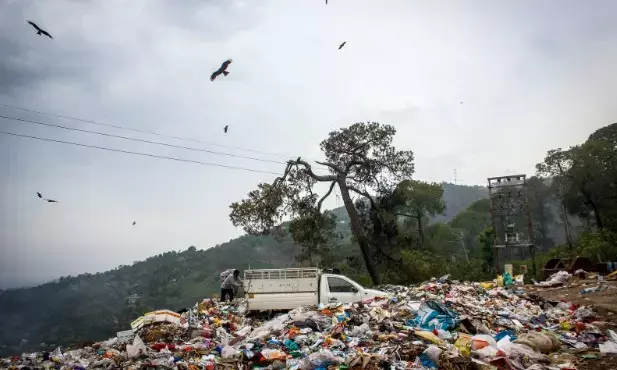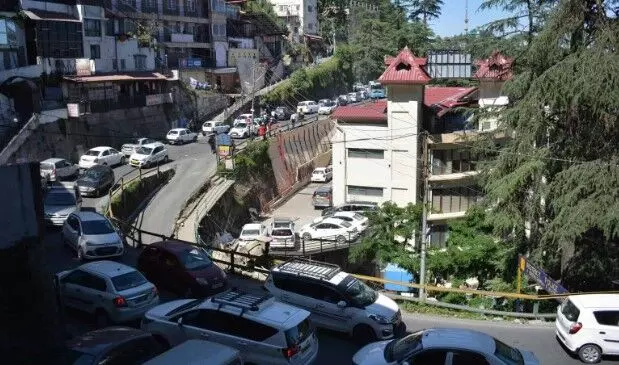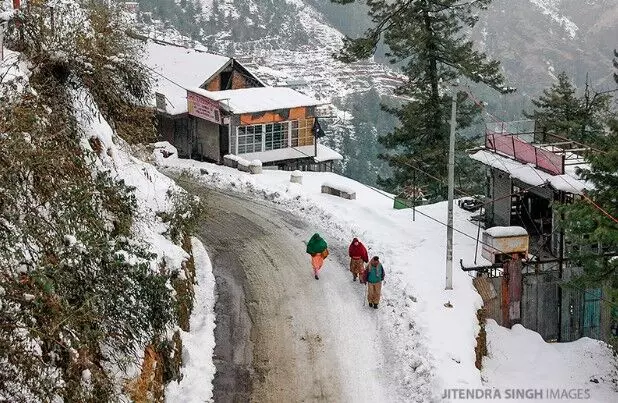Himachal Pradesh Crumbles Under Tourist Avalanche
'There has to be an element of planning'

SOLAN: It has become a routine with ever increasing intensity. Tourist season in the hills no longer is something to look forward to, having assumed nightmarish propositions where not only the locals are left hassled, high and dry but the tourists also leave disappointed on not getting what they had expected.
Tourist destinations in Himalayan states like Himachal Pradesh are crumbling under the weight of ever increasing tourist arrivals. With the infrastructure and environment unable to meet the increasing requirements, the result is there for everyone to see.
Your imagination of a leisurely drive through winding roads and pristine locales with a forest of green on either side is now a utopian dream, as people are greeted with traffic snarls right from the entry points of major destinations like Shimla, Dharamshala and Manali.
Then there is the question of basic amenities. The acute water scarcity in Shimla is once again making headlines, reminding people of the harrowing days in 2018 when boards had come up asking tourists not to visit Shimla.
How did we create this mess?
To begin with, the summer tourist season this year is the first full fledged season since the pandemic and thoughtless lockdowns that ensured zero tourist arrivals in 2020 and only partial recovery the following year.
Sources in the industry also point out that many visitors to Himachal are keen now to stay outside the traditional tourist towns, and prefer staying at homestays in small villages away from the urban centres, and are willing even to walk to remote locations for the experience.
At the same time hotel occupancy in traditional destinations hasn't come down, which simply points to a multifold increase in arrivals. Sources underline that the trend means success for the bed and breakfast initiative of the state government that allowed people in rural areas to get their premises registered as homestays and earn extra money in a jobless economy by hosting tourists. But all this has resulted in growing pressure on the local wildlife and living trees along with rampant unplanned construction in the rural areas.
The third factor playing out in the current season is the recent spate of murders in Kashmir, and the resulting uncertainty and insecurity that has diverted tourists bound for the valley to neighbouring states, adding to the usual arrivals.
Then of course there are the unprecedented heat waves worsened by agroindustrial global warming. These waves have scorched even the hills with the added menace and destruction of a large and growing number of forest fires. Yet tourists continue to drive in, as at least the evenings offer a cool breeze and even daylight temperatures are cooler than in the plains, whose cities are no less than furnaces now.

Meanwhile reports of erratic water supply in Shimla have resurfaced to haunt the residents. Some localities are only getting water at four days' interval with people forced to make long queues at traditional sources to fetch drinking water after a long wait. They point out that VIP visits to the pollbound state have meant the top slot of the administration being tied down and the masses left to the mercy officials.
"It's a case of 'the state has withered'. There is ample availability of water even if we assume a 100% rise in the population of the town over the Census figures of 2011. But this is plain mismanagement," said Shimla's former mayor Sanjay Chauhan who has been at the forefront of raising the issue of basic amenities for local residents.
And the capital city is witnessing choked arterial roads from all sides because of the traffic. Its residents have often said that tourists need to be encouraged to use public transport to reach the town, but hardly any effort is made in this direction, leading to thousands of vehicles entering the city every day and causing massive jams.
"We had come up with a city mobility plan. There was the plan to have an alternate ropeway from just near the Tutikandi bus stand on the outskirts with a parking facility of around 1000 vehicles. The ropeway would be an attraction for the tourists while reducing the pressure on the roads. Similar initiatives can also be taken from other approach points like Mashobra, Dhalli etc. But this needs some out of the box thinking," Chauhan told The Citizen.
"Similarly, it is a well known fact that Shimla is a walkable city. Why not have a tunnel built from Chhota Shimla to the Lift so that the people can easily cover the distance walking instead of having to use vehicles? Making a tunnel is no longer a difficulty and causes no harm to the green cover. These tunnels can be made on several routes. But unfortunately the approach is just to widen roads which leads to chopping of trees without addressing the problem. Today you can see vehicles parked on both the sides of the roads in Shimla," he added.
The scenario is equally bad in Manali where sources in the hotel industry say the infrastructure isn't keeping pace with the exponential growth in tourist arrivals. They point out that whether it is the sewerage or water supply pipelines, they have not been upgraded for years. They also expressed concern over garbage from the hotels going into the Beas river, and said that if water is drawn from the river it is muck that comes up.
People in Manali also say that even basic things like hygienic public toilets are not available, unlike in Chandigarh or Shimla. "Imagine the tourists reaching Manali in the middle of the night after travelling for more than 10 hours in a bus and finding no place to ease themselves. Many of them are compelled to rent a room in the first hotel available and pay whatever is demanded just because of their compulsion to ease themselves. On the entire route it is the petrol pump washrooms that provide relief to the travellers. While the locals are used to easing themselves in the open behind the bushes, the city folk are simply not used to it," a hotelier explained.
Then there is the issue of traffic on the roads leading to places like Manikaran, Tosh and Kasol. It can take up to four hours just to reach Bhuntar from Kasol, a distance of 30 kilometres. In addition there are the frequent power breakdowns and delays in getting them rectified. "The locals are used to there being no power for a couple of days at a stretch but you cannot expect the tourists to bear with it," said a stakeholder from Tosh.
People in the industry also want matters pertaining to the plying of private luxury buses from Delhi and other places sorted out once and for all without travelers being harassed.
"The government seriously needs to upgrade the basic infrastructure in this area. They can take a leaf from Chandigarh and at least provide clean toilets to the travelers along the route. The sewerage and water pipelines need to be upgraded and a proper waste disposal mechanism needs to be put in place," said local hotelier Anil Kant.
This brings us to the most important question, of the need to decentralize the tourism industry and develop new destinations away from overburdened ones like Shimla, Manali and Dharamshala.
Recently it was Arki legislator Sanjay Awasthi who came up with an interesting proposal in the state assembly where he stressed the need to develop water sports and other activities along the Sutlej river from Tattapani to Harnoda. "The possibilities of having a steamer service, rafting and even scuba diving need to be explored. The villages along the route can offer camping facilities besides local cuisine. This will provide self-employment avenues to the local youth and will uplift the local economy," he said.
Even the chief minister, Jai Ram Thakur recently talked about developing tourism in the Janjheli area of his constituency, Seraj. He stated that several less known destinations are being developed under the government's 'Nai Raahein, Nai Manzilein' program (new roads, new destinations).
But although the idea of decentralizing fascinates it has its own set of challenges. For example there are several spots where locals do not want the intrusion of tourists, who indulge in littering, substance abuse including alcohol, and indecent behaviour. There have been reports of locals complaining that places where women graze their animals and rest during the day, or where children play have been invaded by the 'ugly tourist'.
Recently it was Kisan Sabha leader Kuldip Tanwar who drew the administration's attention to another aspect, of resource consumption. When a delegation of leaders from four panchayats of the Kasumpti area of Shimla approached the authorities of the Jal Shakti Department, they drew attention to the sale of water from local sources in the Naldehra panchayat to hotels being built in the area. The representatives said the policy on the use of underground water is not being implemented properly. They said that while a whole lot of hotels and resorts have come up on the periphery of Shimla, their water needs have not been addressed. So they exploit the local resources causing hardship to people who live there.

So where lies the solution to these issues along with many more related to them?
Manshi Asher of the Himdhara Collective thinks that one of the first things that need doing is to analyze the carrying capacity of tourist destinations. "Then there has to be a participatory approach to the matter. There needs to be a dialogue between the operators and the administration, after which plans need to be made. These plans should be implemented through the panchayats and their various committees. A lot of micro-planning is needed and the panchayats need to be given powers to strengthen them. They can then impose fines on littering, make tourists aware about responsible tourism and take other initiatives to check littering. These exercises have been undertaken in certain places in Nepal and Uttarakhand."
She further added, "The youth is a big stakeholder in the entire scheme of things where he or she sees an earning opportunity. They need to be trained in different aspects of biodiversity, conservation and protection which they can further take to the tourists to help them explore and educate. There is a lot of work that needs to be done."
Asher also believes that the whole eco-tourism initiative needs to be decentralized from the hands of the Forest Department and should have major involvement of the local communities. "The forest rights of the communities should be recognized. The whole idea of giving facilities on rent to outsiders alienates the communities," she explained.
Awasthi referring to his water sports proposal said, "If you have the locals as the key stakeholders, they will ensure that the tourists behave responsibly. They will not allow littering of any place as their livelihood is at stake. They will also ensure proper disposal of waste. An added advantage would be that the migration of the youth from villages to urban areas of the state and even other states will be kept in check."
Kullu-based Aditi Chanchani who has been working in the field of promoting responsible tourism believes that initiatives under a framework of the Forest Rights Act, gram panchayats, and the Panchayats (Extension to Scheduled Areas) Act can go a long way. "The process that starts with exploring the unexplored gradually leads to more footfalls and unplanned urbanization. The problem aggravates in the absence of policy and regulations," she explained.
A case in point is the growing number of tourists to Sissu in the Lahaul and Spiti district after the opening of the Atal Tunnel in 2020. She expressed the fear that Sissu would soon go the Manali way unless timely measures are taken to check traffic, construction and the resulting pollution.
Sources in Manali said that instead of taking tourists to the famous Rohtang Pass for a daily trip involving tedious paperwork, many operators now opt to take tourists to Bara Lacha La instead. "They start in the morning and are back by the evening. It is fast becoming a more sought after destination than Rohtang pass," a hotelier said.
Referring to the constructions in parts of Lahaul, Chanchani said, "It is well known that many spots in the area are avalanche prone. But no one considers it. There has to be an element of planning."
Referring to the recent Covid19 experience she pointed out that tourism cannot be the mainstay of an economy and needs to be looked at as part of the development strategy and regional structure.
She also highlighted the most important task of taking the carrying capacity of a place into consideration. "Between Banjar and Goshiani alone there are hundreds of homestays that have come up. Is that really the capacity of the place? Capacity is not just the numbers of arrivals but a whole range of different aspects," she said.
Chanchani agreed that the involvement of communities through the Forest Rights Act is needed in conservation and the management of tourist destinations. Tourism needs to be brought under the purview of Forest Rights Management Committees led by local people. "After all, what are you selling? It is the view, landscape and green cover. You are dependent on forests and water resources," she said.
As for tourist waste, while it is largely believed that plastic is the main problem when it comes to waste disposal in the mountains, broken glass bottles are an equal menace. Plastic can still easily be lifted and dumped in the bags to be taken away for disposal, but it is very difficult to collect broken shards of glass bottles which pose a far greater health hazard. Waste segregation remains one of the biggest challenges for tourism stakeholders in the state.
Stakeholders are also annoyed by the failure of the authorities to check illegal constructions, particularly along water bodies. They say that all norms pertaining to the distance from water bodies where buildings can come up continue to be flouted with impunity.
Chanchani pointed out that despite efforts there are very few tourists who actually want to indulge in responsible tourism. So the need of the hour is to bring in a system beginning with education and awareness that leaves no choice before the tourist except to go by the norms of responsible tourism. They need to be given no option right from the start. "There has to be a defined sustainable tourism," she said.



